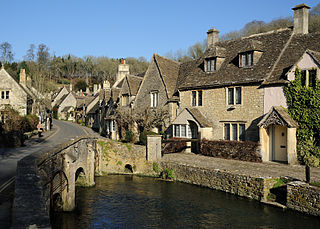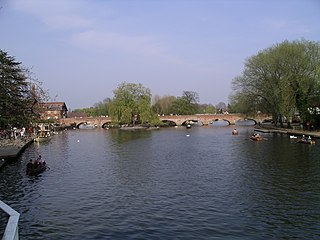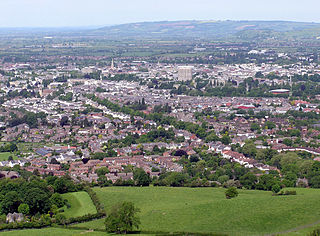
The Cotswolds is a region in central-southwest England, along a range of rolling hills that rise from the meadows of the upper Thames to an escarpment above the Severn Valley and Evesham Vale.

Gloucestershire is a county in South West England. The county comprises part of the Cotswold Hills, part of the flat fertile valley of the River Severn and the entire Forest of Dean.

The River Avon in central England flows generally southwestwards and is a major left-bank tributary of the River Severn, of which it is the easternmost. It is also known as the Warwickshire Avon or Shakespeare's Avon, to distinguish it from several other rivers of the same name in the United Kingdom.

Cheltenham, also known as Cheltenham Spa, is a large spa town and borough on the edge of the Cotswolds in the county of Gloucestershire, England. Cheltenham became known as a health and holiday spa town resort, following the discovery of mineral springs in 1716, and claims to be the most complete Regency town in Britain.

Evesham is a market town and parish in the Wychavon district of Worcestershire, in the West Midlands region of England. It is located roughly equidistant between Worcester, Cheltenham and Stratford-upon-Avon. It lies within the Vale of Evesham, an area comprising the flood plain of the River Avon, which has been renowned for market gardening. The town centre, situated within a meander of the river, is subjected regularly to flooding. The 2007 floods were the most severe in recorded history.

Tewkesbury is a medieval market town and civil parish in the north of Gloucestershire, England. The town has significant history in the Wars of the Roses and grew since the building of Tewkesbury Abbey. It stands at the confluence of the River Severn and the River Avon, and thus became an important trading point, which continued as railways and later M5 and M50 motorway connections were established. The town gives its name to the Borough of Tewkesbury, due to the earlier governance by the Abbey, yet the town is the second largest settlement in the Borough. The town lies on border with Worcestershire, identified largely by the Carrant Brook.

The Malvern Hills are in the English counties of Worcestershire, Herefordshire and a small area of northern Gloucestershire, dominating the surrounding countryside and the towns and villages of the district of Malvern. The highest summit affords a panorama of the Severn Valley, the hills of Herefordshire and the Welsh mountains, parts of thirteen counties, the Bristol Channel, and the cathedrals of Worcester, Gloucester and Hereford.

Pershore is a market town in the Wychavon district in Worcestershire, England, on the banks of the River Avon. The town is part of the West Worcestershire parliamentary constituency. At the 2011 census, the population was 7,125. The town is best known for Pershore Abbey, Pershore College and plums grown locally.

The Cotswold Line is an 86+1⁄2-mile (139.2 km) railway line between Oxford and Hereford in England.

Eckington is a small village near to the southern border of the English county of Worcestershire, according to the 2001 census it had a population of 1,202.

The region now known as Gloucestershire was originally inhabited by Brythonic peoples in the Iron Age and Roman periods. After the Romans left Britain in the early 5th century, the Brythons re-established control but the territorial divisions for the post-Roman period are uncertain. The city of Caerloyw was one centre and Cirencester may have continued as a tribal centre as well. The only reliably attested kingdom is the minor south-east Wales kingdom of Ergyng, which may have included a portion of the area. In the final quarter of the 6th century, the Saxons of Wessex began to establish control over the area.

Medieval reenactment is a form of historical reenactment that focuses on re-enacting European history in the period from the fall of Rome to about the end of the 15th century. The second half of this period is often called the Middle Ages. This multiplicity of terms is compounded by the variety of other terms used for the period.

Alderton is a village and civil parish in the Tewkesbury district of Gloucestershire, England.

Moreton-in-Marsh railway station is a railway station serving the town of Moreton-in-Marsh in Gloucestershire, England. It is on the Cotswold Line between Kingham and Honeybourne stations. The station and all passenger trains serving it are operated by Great Western Railway.
Cirencester and Tewkesbury was a parliamentary constituency in Gloucestershire which returned one Member of Parliament (MP) to the House of Commons of the Parliament of the United Kingdom. It was created for the 1918 general election and abolished for the 1997 general election when it was partly replaced by the new constituencies of Cotswold and Tewkesbury.

Vikings of Middle England is a Viking re-enactment and living history group based in Leicester, UK. They portray the people who lived, travelled to and invaded Britain in the Viking-Age. Tÿrslið's aim is to entertain and educate an audience using a mix of drama, pageant, special effects, historical context, demonstration and audience participation. Tÿrslið are one of the few groups to display Icelandic Horses in a Viking-Age presentation, with horses and riders from Oakfield Icelandic Horses joining them at events. As well as arena-displays, Vikings of Middle England erect a Living History encampment where members demonstrate Viking-age crafts such as blacksmithing or where the audience can have a go at certain activities such as coin-striking. The organisation once owned a scale replica Longship called Ratatosk.
Historical re-enactment in Australia has been occurring since at least the early 1970s. With no conventional land battles and few protracted civil disturbances since the British colonisation of Australia, most military re-enactment in Australia focuses on events from other countries, including the European Feudal, medieval, and renaissance eras.

Bretforton is a rural village in Worcestershire, England, 4.4 miles (7.1 km) east of Evesham, in the Vale of Evesham. It is the largest farming village near Evesham. At the 2001 census, Bretforton had a population of 1,023 in 428 households. The area of the parish is 2.83 square miles.
The Medieval Siege Society is a British living history and combat reenactment association dedicated to costumed reenactment of siege warfare, combat reenactment and events surrounding the history known as the Hundred Years War and the Wars of the Roses. Apart from reenactment, it is also involved in research into the history of the period, and education about the same.
History Live is an annual summer event held by English Heritage. The event focusses on historical re-enactment. The first event was held in 2003 and attracted 10,000 visitors, and since then has been held annually in July or August in the grounds of Stoneleigh Park in Warwickshire or Kelmarsh Hall in Northamptonshire. It is Europe's biggest historical event.





















